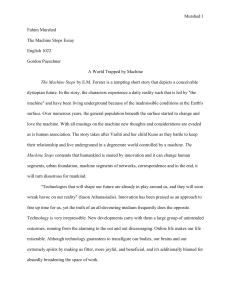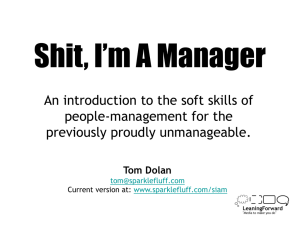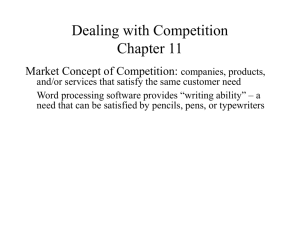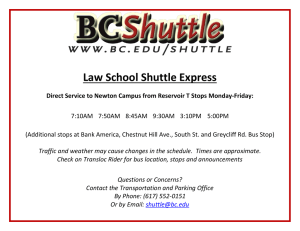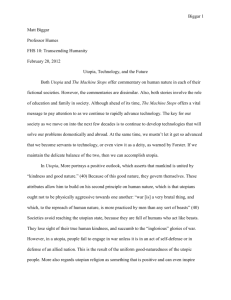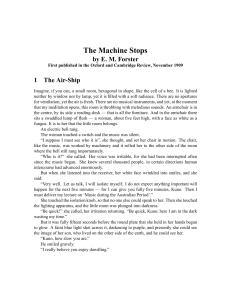LECTURE SEVEN Materials to Guide Reading
advertisement
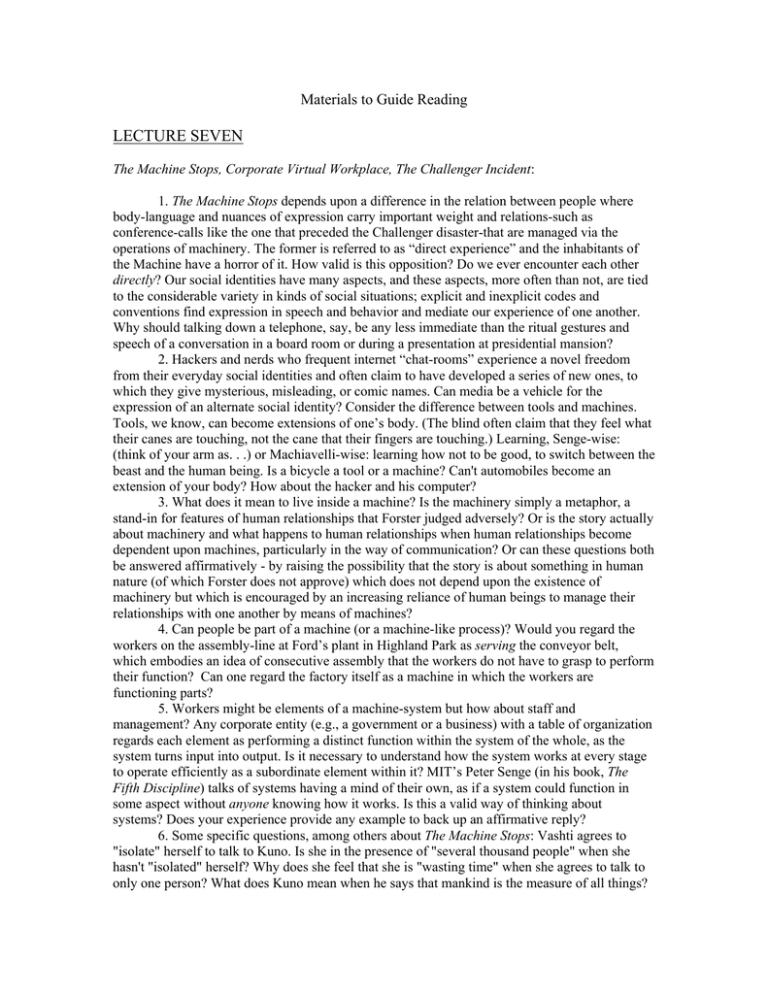
Materials to Guide Reading LECTURE SEVEN The Machine Stops, Corporate Virtual Workplace, The Challenger Incident: 1. The Machine Stops depends upon a difference in the relation between people where body-language and nuances of expression carry important weight and relations-such as conference-calls like the one that preceded the Challenger disaster-that are managed via the operations of machinery. The former is referred to as “direct experience” and the inhabitants of the Machine have a horror of it. How valid is this opposition? Do we ever encounter each other directly? Our social identities have many aspects, and these aspects, more often than not, are tied to the considerable variety in kinds of social situations; explicit and inexplicit codes and conventions find expression in speech and behavior and mediate our experience of one another. Why should talking down a telephone, say, be any less immediate than the ritual gestures and speech of a conversation in a board room or during a presentation at presidential mansion? 2. Hackers and nerds who frequent internet “chat-rooms” experience a novel freedom from their everyday social identities and often claim to have developed a series of new ones, to which they give mysterious, misleading, or comic names. Can media be a vehicle for the expression of an alternate social identity? Consider the difference between tools and machines. Tools, we know, can become extensions of one’s body. (The blind often claim that they feel what their canes are touching, not the cane that their fingers are touching.) Learning, Senge-wise: (think of your arm as. . .) or Machiavelli-wise: learning how not to be good, to switch between the beast and the human being. Is a bicycle a tool or a machine? Can't automobiles become an extension of your body? How about the hacker and his computer? 3. What does it mean to live inside a machine? Is the machinery simply a metaphor, a stand-in for features of human relationships that Forster judged adversely? Or is the story actually about machinery and what happens to human relationships when human relationships become dependent upon machines, particularly in the way of communication? Or can these questions both be answered affirmatively - by raising the possibility that the story is about something in human nature (of which Forster does not approve) which does not depend upon the existence of machinery but which is encouraged by an increasing reliance of human beings to manage their relationships with one another by means of machines? 4. Can people be part of a machine (or a machine-like process)? Would you regard the workers on the assembly-line at Ford’s plant in Highland Park as serving the conveyor belt, which embodies an idea of consecutive assembly that the workers do not have to grasp to perform their function? Can one regard the factory itself as a machine in which the workers are functioning parts? 5. Workers might be elements of a machine-system but how about staff and management? Any corporate entity (e.g., a government or a business) with a table of organization regards each element as performing a distinct function within the system of the whole, as the system turns input into output. Is it necessary to understand how the system works at every stage to operate efficiently as a subordinate element within it? MIT’s Peter Senge (in his book, The Fifth Discipline) talks of systems having a mind of their own, as if a system could function in some aspect without anyone knowing how it works. Is this a valid way of thinking about systems? Does your experience provide any example to back up an affirmative reply? 6. Some specific questions, among others about The Machine Stops: Vashti agrees to "isolate" herself to talk to Kuno. Is she in the presence of "several thousand people" when she hasn't "isolated" herself? Why does she feel that she is "wasting time" when she agrees to talk to only one person? What does Kuno mean when he says that mankind is the measure of all things? The Book of the Machine is a set of instructions for operating the cell inhabited by each of the people of the Machine plus a set of timetables for various public facilities. Vashti holds it "reverently", kisses it, and feels "the delirium of acquiescence." What is she "acquiescing" to? Regard for the Machine is presented in the text as a kind of misplaced form of religious worship, and yet there is much talk that the present age has successfully banished superstition. Is this a contradiction? How about the notion that each year (p. 263.) the machine is served more efficiently and less intelligently? 7. The world in The Machine Stops has rejected intimacy and bodily expressiveness in communication; the world in “Corporate Virtual Workplace” presumably captures such things, but shows them entirely satisfied by virtual experiences of diagrams, charts and business presentations. Would you want your managerial life to be spent in this way? How closely does the text actually capture aspects of contemporary managerial experience, even though the kind of virtual reality described does not yet exist? Would you like to borrow Johann’s “concept canon”? Does Johann’s idea of “concept” here echo the notion of “ideas” held by the inhabitants of Forster’s Machine? Johann is doubtful of diagrams whose symbols “have little correlation with their physical counterparts”; doesn’t this set his concepts apart from Vashti’s “ideas”? How well does Austin understand the corporation for whom he is working at the moment? The essay proposes that he knows all he needs to know. Why would he want to know more? 8. “Whereas non-software objects in the real’ world play out roles prescribed by nature’s rules, software objects will act out roles in compliance with rules enforced by their hosting cyberspace.” (p. 398.) What is the implication of this comparison? What is the point of the scarequotes surrounding the word real? 9. The article on the Challenger disaster comes with its own interpretation of the incident’s implications for business ethics. This section was added after the rest of the article had been published. In your view is the interpretation provided adequate to the case? Have the writers caught its essential message? 10. Imagine Roger Boisjoly arguing against the Challenger launch in the world of Corporate Virtual Workplace. (Recall that his efforts during the final telecommunications conference relied on shuffling diagrams, charts, and illustrations.) Imagine as well that management had the same resources to communicate to each other the extent of the disaster for Morton-Thiokol should the launch be canceled and the contract currently under renegotiation not renewed. Would the outcome have been different if both possibilities-launch disaster, financial disaster-had been presented with the graphic immediacy that the Pruitt and Barrett article proposes for all business encounters? Do management and engineers live in different "virtual realities"? 11. Suppose that Morton-Thiakol successfully dodged this bullet-that the launch went off without a hitch. What credit would Boisjoly gain from trying to prevent it? How much credit can corporations ever award for preventing accidents that did not happen?
